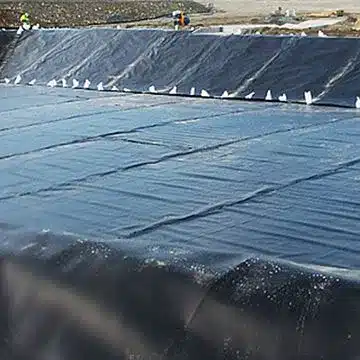+86-159 9860 6917
info@geofantex.com
geofantex@gmail.com
+86-400-8266163-44899
Geomembrane liner products are the unsung heroes of environmental protection and containment solutions. These highly adaptable synthetic materials, often composed of polymers like HDPE, LDPE, and PVC, serve as a reliable shield against liquid and gas infiltration. Geomembrane liners find their purpose in diverse applications, from safeguarding our ecosystems in landfills and wastewater treatment plants to enhancing agricultural practices through efficient water management. In industrial sectors like mining and oil & gas, they play a pivotal role in containing hazardous substances.

What are geomembrane liners made of?
Geomembrane liners are impermeable synthetic materials meticulously engineered from a variety of polymers, including PVC film, HDPE film, LDPE film, EVA film, and ECB film. Each of these materials boasts its unique advantages, making geomembrane liners suitable for a wide range of applications.
1. Polyethylene (PE): Geomembranes crafted from Polyethylene (PE) stand out as a cost-effective choice, widely employed across diverse applications. Within the PE category, you’ll find high-density (HDPE) and low-density (LDPE) variations, with HDPE specifically prized for its exceptional strength and chemical resistance.
2. Polyvinyl Chloride (PVC): PVC geomembranes, made from PVC film, are renowned for their remarkable UV resistance and flexibility. These geomembranes are particularly favored in situations where resistance to chemicals and corrosion is paramount.
3. Ethylene Propylene Diene Monomer (EPDM): EPDM geomembranes, composed of EVA film, excel in durability and UV radiation resistance. They frequently find use in applications such as pond liners and landscaping, where longevity is a key consideration.
4. Polypropylene (PP): Geomembranes constructed from Polypropylene (PP) film are an ideal choice for applications demanding top-notch chemical resistance. Commonly found in waste containment and environmental protection endeavors, these geomembranes serve as dependable barriers.
5. Chlorosulfonated Polyethylene (CSPE): CSPE geomembranes, featuring ECB film, are celebrated for their resistance to ozone and various chemicals. This exceptional resilience makes them a suitable choice for industrial applications where durability is critical.
Incorporating these diverse materials into geomembrane liners ensures that there’s a tailored solution for every liquid containment and environmental protection need. The choice of polymer film – whether PVC, HDPE, LDPE, EVA, or ECB – enables geomembrane liners to deliver on their impermeable promise, safeguarding the environment and infrastructure across various industries.
What are the different types of geomembrane liners?
Types of Geomembrane:
Geomembrane liners are available in a variety of types, each carefully engineered to address specific needs:
- Smooth Geomembranes (including PVC Liner and EPDM Rubber Liner): These liners are characterized by their sleek, untextured surface. Smooth geomembranes, such as PVC liners and EPDM Rubber liners, are often chosen for applications where the primary concern is liquid containment. They offer a cost-effective solution that is both easy to install and reliable.
- Textured Geomembranes (including Geosynthetic Clay Liner and Thermoplastic Sheet Liners): Textured geomembranes, like Geosynthetic Clay Liners and Thermoplastic Sheet Liners, are designed with a textured surface to enhance friction and stability. They are commonly employed in applications where slope stability and resistance to friction are of utmost importance.
- Reinforced Geomembranes (including Concrete Geocomposite Liner): Reinforced geomembranes go a step further by combining geomembranes with geotextiles, significantly boosting their tensile strength and puncture resistance. These liners, including the Concrete Geocomposite Liner, are indispensable for applications demanding additional strength, such as landfill covers.
What does a geomembrane liner do?
Geomembrane liners serve a multitude of purposes, including:
1. Liquid Containment: Geomembrane liners act as a barrier, preventing moisture from penetrating the walls and foundation of the building, making them crucial in applications like landfill lining, pond and reservoir construction, and wastewater treatment facilities.
2. Environmental Protection: They protect the environment by acting as a barrier, preventing the migration of contaminants from hazardous waste sites and landfills into the surrounding soil and water.
3. Erosion Control: In applications where erosion control is essential, geomembrane liners can be used to stabilize slopes and act as a barrier against soil erosion.
4. Water Conservation: Geomembrane liners are used to line canals, reservoirs, and water storage facilities, acting as a barrier and preventing water loss due to seepage.

What is the difference between a geomembrane and a pond liner?
While both geomembranes and pond liners serve as barriers to liquid containment, there are some distinctions:
1. Material: Geomembrane liners are more impermeable and can be crafted from various materials, including PVC, PE, EPDM, and more, whereas pond liners are typically made of EPDM or PVC.
2. Purpose: Geomembranes are employed in a wide range of applications beyond pond lining, such as landfills and wastewater treatment, owing to their enhanced impermeability. Pond liners, on the other hand, are specifically designed for water features like ponds, lakes, and decorative water bodies.
3. Design: Pond liners often incorporate a textured or reinforced surface to provide extra durability and resistance to punctures in aquatic environments. In contrast, geomembrane liners offer a broader spectrum of textures and reinforcements, precisely tailored to specific applications, further emphasizing their superior impermeability.



Get Free Sample
We’ll respond as soon as possible(within 12 hours)






















